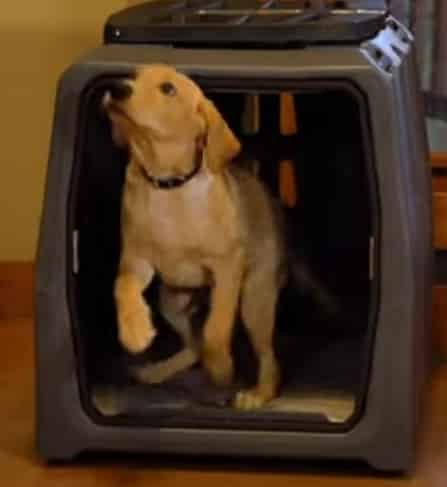However unpleasant it is, dog poop is a topic that will often pop up during pet parenting. For instance, you may sometimes notice that your lab puppy alleviates more after some meals than others.
Most lab puppies poop 2-3 times daily. However, the frequency depends on other factors such as age, size, activity level, size, and how often you take them for a walk. Additionally, your pup’s health condition and how many times you feed them determine how often they’ll need to visit the toilet.
Read on for more insights into how often your lab needs to defecate, when to start training your labrador puppy, and how to take care of a month-old puppy.
Table of Contents
How Often Does a Lab Puppy Need To Go to the Toilet?
The number of times your pup needs to visit the toilet will vary depending on their age, diet, size, activity level, and how frequently you take them for walks.
As this discussion thread indicates, most pet parents report that their labs poop 2-3 times daily.
However, your pup may eliminate more than three times if you feed it more frequently. Also, the frequency depends on your lab’s health condition.
Have you ever noticed that dogs eventually fall into a routine and start pooping at around the same frequency and number of times daily? That is because they are creatures of habit.
It would be better to monitor your dog during meals and at least for one hour after every meal. This is because pups tend to eliminate within 30 minutes after meals.
As a rule of thumb, you should take your puppy to its bathroom spot:
- Just before you go to sleep.
- The fast thing when you get out of bed in the morning.
- Immediately the puppy rises after a nap.
- Within 30 minutes after meals.
- After playing or episodes of excitement.
It would help if you also kept in mind that:
- More food means more stools.
- Intake of insufficient or too much fiber can cause diarrhea or constipation.
- Any change in your dog’s waste points to a health problem.
You should immediately call your vet if your pup hasn’t pooped for more than 48 hours.
How to Potty Train a Lab Puppy Without a Crate

As a pet owner, you may not have enough room for a crate, or you may dislike the idea of changing your home’s interior design to accommodate one. Nonetheless, that should not deter you from housebreaking your pup.
Here are the five steps you can follow to housebreak your lab without using a crate:
- Establish a feeding and elimination schedule. You should establish feeding times for your lab and allocate the first 30 minutes after each meal to alleviation. Additionally, you may take your lab outside every 2 hours as you begin training. Extend the time between breaks by one hour each week until your puppy is conditioned to eliminate during specific times.
- Identify a suitable spot for your puppy to go potty in. Take your lab to this spot regularly, especially when you spot them circling, squatting, trying to escape to a quiet place, or sniffing the ground.
- Reward them for eliminating at the chosen spot. You should praise your lab every time they use their bathroom. Give treats or pet them – this creates positive reinforcement. Conversely, you should never punish your pup if they use an undesignated area; it may slow down their learning.
- Whenever you catch your puppy in the act in an undesignated area, startle them with some noise. However, you should not scare them. Instead, take your puppy to the designated bathroom immediately so that they can finish their business.
- Teach them to pee or defecate at your command. Each time your pup eliminates in the designated area, mark the occasion by using phrases such as “be quick” or “awesome lab.” After several weeks, you may notice your Labrador pup showing an urge to eliminate when you use the chosen phrase.
We recommend that you watch the following video for further explanation on how to housebreak your puppy:
How Long Does It Take to House Train a Lab Puppy?
Housebreaking your lab is a process that requires patience. As a pet parent, it would be better if you’re aware that potty training takes months.
As this discussion thread indicates, some lab owners have reported that it took up to 5 months to train their puppies.
However, it could take up to 8 months. That is because the training period depends on other factors, such as your pup’s enthusiasm and how you train it.
When Should You Start Training a Labrador Puppy?
Now that you’re aware of how to train your lab without a crate and how long the training takes, you may be curious about the ideal time to start training them.
You can begin training your lab once they are 8 weeks old. According to Easy Retriever Training, your puppy has received sufficient foundational training at that age, an aspect that simplifies your work.
Notably, the pup’s mom and littermates have taught them the basics, such as keeping their “room” clean and how to bite.
Therefore, your pup has acquired essential, natural, and intuitive training by the age of 8 weeks.
At 6-9 months, you can begin obedience training by teaching your pup basics, such as stay, sit, down, and off.
However, you should watch out if your lab is very active. That means they will need enough regular exercise to enjoy the training sessions.
Caveat: Before training your pup, ensure you know how to do it. Alternatively, you may hire a licensed trainer for better results.
How Do You Take Care of a 1-Month Old Puppy?
Just like humans, a newborn pup’s primary activities include feeding, socializing, and keeping warm.
In most cases, the mother dog usually provides the care. However, you may be forced to step in sometimes, especially if the mother has rejected the little ones, is sick, or cannot produce enough milk.
To take care of a 1-month old lab, you must pay attention to the following:
Food
By the age of four weeks, your pup has developed tiny teeth and can start weaning. You should initially provide supplemental bottle feedings.
Prepare a milk replacement formula using warm water. After that, use a puppy bottle to feed your lab. You should feed your pup 2-3 times per day.
Not sure about the replacement formula to use? We recommend the KMR 2nd Step Formula from Amazon.com. It is highly digestible and nutritious, making the transition from milk to solid foods easy.
However, ensure you check the label instructions to determine the right amount to feed the little pup.
According to the American Society for the Prevention of Cruelty to Animals, you should gradually introduce solid food by mixing canned food with the formula or water or soaking kibble until it softens.
Socialization
Your pup must grow close to their mom and siblings at this young age.
If that does not happen, your pup may show strange behavioral problems, such as fearfulness, aggression, and sound sensitivity.
Therefore, you should find a female dog that can snuggle and play with your pup, lick, or discipline it.
Alternatively, you should introduce your lab to other puppies to enable them to develop socially.
Health
The health of a month-old puppy can deteriorate quickly if they become sick.
You should continuously monitor their health and note down any reductions or stagnations in weight, lethargy, vomiting, or diarrhea. Call your vet immediately if you spot these.
The Environment
Your home should be clean and free of pests to maintain a healthy pup.
You should also provide your lab a comfortable crate with sufficient space for turning and standing.
Besides, you should keep your pup clean by gently brushing or wiping them with a warm, damp washcloth.
Final Thoughts
How often your lab poops will depend on several factors, notably their size, age, health condition, and feeding habits.
Nonetheless, you can housebreak your lab by beginning training as soon as they are eight weeks old.
You can do that by establishing a feeding and elimination schedule, identifying a suitable spot for your puppy to eliminate, and rewarding them. However, you should be patient since the training may take up to 8 months.
Finally, you should take care of your month-old lab by weaning them appropriately, monitoring their health, ensuring they socialize, and keeping their environment clean.
Related Articles
- What Color Are Chocolate Labs At Birth? Fact Not FictionLabradors are immensely popular as pets due to their intelligence, gentle nature, and trainability – they are also very patient with children. Everyone can agree that all Labradors are adorable
- Is Breeding Labs Profitable? Facts Not FictionBreeding Labradors is a potentially highly profitable market due to the high and constant demand across the world. But to truly make the most of such an endeavor, a breeder must be very thorough with their plans, particularly their budget.
- What Happens When You Breed A Chocolate And Yellow Lab?Breeding a chocolate labrador with a yellow labrador can be complicated with unexpected results. There are six possibilities for offspring color combinations, and much depends on the parents’ genotype.
- Are Silver Labs Good Hunting Dogs? Myth DebunkedA silver lab would make a great hunting dog. There are two types of silver labs: English silver labs and American silver labs. While you can try to train either for hunting, the English lab is designed for shows, while the American lab is designed for hunting.
- What Is The Oldest Age A Labrador Can Have Puppies? Fact Not FictionEight is the oldest age a labrador female can have puppies; however, most responsible purebred dog breeders will retire a female between five to six years of age. Labradors with health problems or injuries may not be eligible to breed. As a responsible dog owner, you must explore the best breeding practices for your Labrador.
